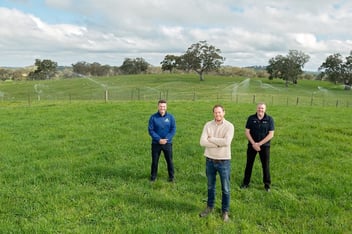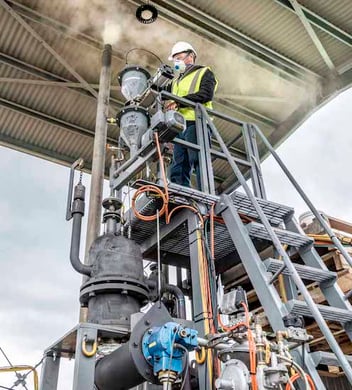Closing the loop: Why water utilities are increasingly treating waste as a resource
As governments around Australia prioritise the circular economy, water utilities are playing a key role in closing the loop. Turning waste into sources of revenue, the sector is helping keep communities clean.
Recycling and re-use are big business, and state governments are laying the groundwork to expand the sector by releasing policies on the circular economy.
In 2019, New South Wales (NSW) released its circular economy policy to improve the management and re-use of waste, while Victoria released a policy earlier this year. And while water recycling has been key to the water sector’s participation in the circular economy, waste re-use and biosolids are also showing huge potential.
Resource recovery
From direct land application to improve soil quality, to co-digestion, waste to energy, and mine rehabilitation, utilities around Australia are exploring novel ways to manage waste streams, turning them into revenue generating resources. Recent research has even found biosolids beneficial for producing bricks in the construction industry.
“The whole space is evolving, and in the near future it may well be that we make bricks and other construction materials out of biosolids," New Zealand’s Watercare Services Resource Recovery Manager Rob Tinholt said.
"There is also the potential to create crude oil out of biosolids. All those futures are something that might be realised over the next few decades.”
Turning waste streams such as biosolids, as well as trade and food waste, into revenue streams has clear benefits for both water utilities and their customers. After Melbourne Water installed its first activated sludge facility at its Western Treatment Plant in 2001, the utility saw a dramatic increase in the production of biosolids.
Initially the biosolids were stockpiled, but with space quickly running out, the utility has been using some of the biosolids for direct-land application on nearby broadacre farms.
“For broadscale agriculture crops like wheat, sorghum and corn, biosolids have been shown to really improve crop yield,” said Kelly Hopewell, Coordinator of Process Engineering at the City of Gold Coast and chair of the Australian and New Zealand Biosolids Partnership (ANZBP) Technical Board.
“This is especially beneficial in Australia with the poor soils that we have.”
https://omny.fm/shows/australianwater/eric-garcin-on-biofactories
Many utilities use biosolids for such direct land applications, and Hopewell said Australia is a world leader in such re-use.
“New Zealand has struggled to have a land application program, and in other areas, like Europe, where they don’t have the land we do, they’ve had to resort to incineration of biosolids, which is not a great way to use the carbon."
While it is great for closing the loop between agriculture and consumption, it does require considerable transport and suitable farming land. For the City of Gold Coast and others in South East Queensland, direct land application means trucking biosolids a considerable way to agricultural areas around Toowoomba for application.
But direct land application has its limits.
“The Western [Treatment Plant] produces over 40,000 dry tonnes of biosolids a year – a big production – and we’ve been using between 3500-6000 tonnes a year for direct land application, so we’re really looking to broaden that to other nearby farming areas,” Melbourne Water Manager of Treatment and Resources, Integrated Planning Jenelle Watson said.
“We’re trying to come up with a basket of biosolids reuse options to enable us to have a reliable, 100% re-use of annual production from Western Treatment Plant within the next 10 to 12 years.”
The utility is currently looking at number of possible solutions, from pyrolysis and gasification to hydrothermal processes such as supercritical oxidation to manage and find end-to-end uses for their biosolids.
“We’re also part of an ARENA project with Southern Oil Refining looking at hydrothermal liquefaction,” Watson said, a process which transforms biosolids into a hydrocarbon product.
Broadening biosolid application
For other utilities, co-digestion of sludge with green and food waste is proving useful for increasing biogas production from wastewater processing, as well as improving the quality of resulting biosolids and increasing the options for their use.
While biosolids with lower contaminant and pathogen grades can be used for broadscale agriculture, their use in urban parks and gardens is limited.
“Stringent guidelines are a good and bad thing for the industry. They protect us, but they also limit which avenues
you can use your biosolids on,” Hopewell said.
“But through composting and co-digestion with green waste, we dilute the chemicals and contaminants and improve biosolid quality.”
"Stringent guidelines are a good and bad thing for the industry."
Kelly Hopewell, City of Gold Coast
The City of Gold Coast is currently looking at the potential of green waste in improving biosolid quality so that it can be used around the city rather than trucked to farms around Toowoomba.
“Eventually we’d like to be able to promote that we are using these products around the City,” she said.
Hopewell and others in the industry agree that moving beyond simple waste management requires a change in mindset, to start seeing waste as a revenue.
“Before we just managed drinking and wastewater services, but now water services, waste and landfill are all managed together, and we have more opportunities. We’re looking at synergies between food waste, green waste, and biosolids, and instead of calling them separate waste streams, we’re calling it our bio-resources strategy,” Hopewell said.
At Watercare Services, Tinholt said a similar change in approach has been essential.
“My job used to be biosolids manager, and now it’s resource recovery manager. It’s deliberately to identify new ways to create beneficial pathways for our resources,” he said.
As industries such as metal plating and others move offshore, Watercare has seen its biosolid contaminant levels improve. And the utility is about to build a thermal hydrolysis plant at its Rosedale water treatment plant, dramatically increasing the pathogen quality of biosolids.
“All being equal, in the near future we will have a class AA biosolid product,” Tinholt said, opening up a range of uses for the biosolids.
Increased treatment of biosolids with process like thermal hydrolysis also boosts the yield of biogas from the process.
“The more biogas you generate, the more electricity. It’s one way to offset the additional treatment, getting green energy credits back by producing green electricity,” Hopewell said.
Food to energy
Meanwhile, Yarra Valley Water (YVW) has found a whole new use for a once difficult waste stream. Food waste and high-strength liquid organic waste is converted to energy at their Wollert waste-to-energy facility in Melbourne’s north.
“Currently our 33,000 tonnes of food waste that we process at Wollert and convert across to electricity then allows us to cover around about 25% of our total energy bills across the business,” YVW Waste to Energy Services Manager Damien Bassett said.
The food waste would otherwise go to landfill, while the high-strength liquid organic waste would normally be disposed through the trade waste system, meaning costly sewer maintenance. According to YVW figures, the plant saves the utility around $60,000 per month.
https://www.youtube.com/watch?v=_SobqWrxxBw
“One of the drivers was to be able to reduce costs overall. By investing in these technologies, it allows us to help in reducing bills,” Bassett said.
Digestate produced from the waste-to-energy plant is currently added to biosolids which then go to the western water treatment plant.
“It has added nutrient value to those biosolids that didn’t exist previously, because our material is organic and quite rich in nutrients,” Bassett said.
YVW is currently working with the Environmental Protection Agency to develop legislation that would facilitate the use of the digestate for other re-use.
Community minded
For the proponents of waste re-use schemes, the benefits for the communities served by water utilities are clear – waste reduction, reduced landfill and greenhouse gas emissions, and an improved environment.
“It’s about intergenerational equity,” Watson said.
“We’re not leaving a stockpile of biosolids for future generations, and reducing stockpiles helps reduce emissions.”
The end products from re-use schemes also benefit communities. And re-use can generate new revenue and savings that can be passed on to customers.
“They can produce alternative fuels or energy, or a compost product that’s great for improving land quality,” Watson said.
Hopewell said: “Beneficially re-using biosolids is much more cost-effective than landfill. If we can divert biosolids away from landfill, then we are saving costs for community.”
A version of this story was first published as 'Waste as a Resource' in Current magazine October 2019.


